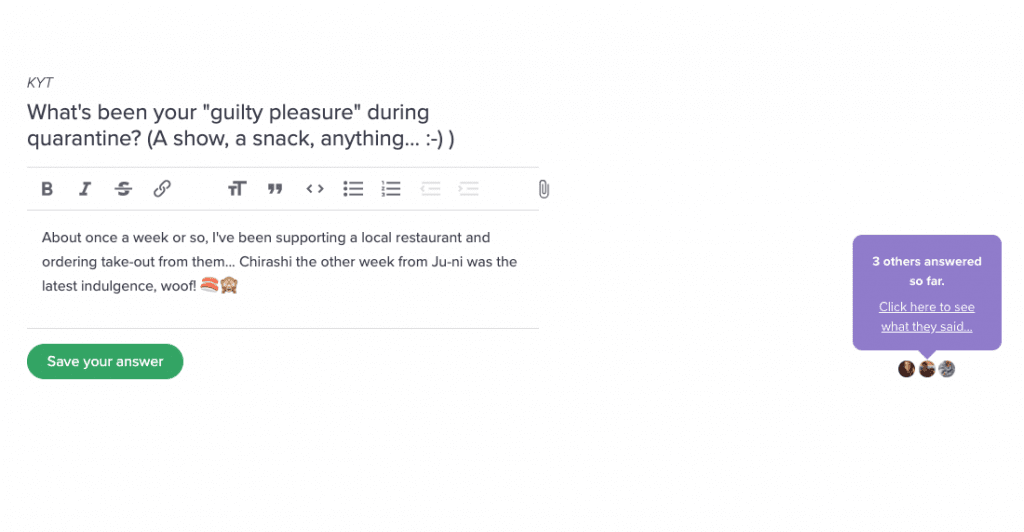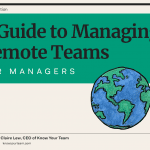You want to help as a manager – but how? Here are 8 ways to help ease stress, improve morale, and make working remotely easier for your team.

You want to support remote employees in your now all-remote team. But how, exactly?
These past few weeks, I’ve gotten countless of questions around how to support remote employees. And so, I thought I’d write up my recommendations here, based on studying remote teams and working with remote teams for the past 6+ years (not to mention, being a remote team, ourselves!)
This may feel salient to you if you’ve found yourself more depleted and anxious as of late as a leader – and you’ve noticed your team is, too. As a result, you’ve been trying to check-in more with your team during these challenging times and ask, “How are you doing?”
But you wonder if there’s anything else – or something more – you should be doing.
I’ve got some answers for you 🙂 To support remote employees during these times, here are 8 things as a manager you can try…
#1: Ask more than just, “How are you doing?”
You’re worried. When your team members hop onto a Zoom call, they seem more worn thin than ever before. As a result, you ask them, “How are you doing?” It’s a reasonable question – but frankly, you’re not going to get a great response.
“How are you doing?” is a pedantic, routine question, and so our answers are often pedantic and routine in reaction to it. For example, the most common answer you’ll likely hear folks tell you is “I’m pretty fine” or “Oh I’m doing okay”… and that’s it.
Instead of only asking “How are you doing?” you’ll want to ask questions that dig deeper and give more space for your team to answer you fully and honestly about how they are doing in reality. Here are some questions you can try asking during a one-on-one meeting…
- Given all the craziness and sadness in the world, how are you holding up?
- What’s your current situation? How are you feeling about it?
- What are you currently doing to sustain yourself? Have you been able to take time for yourself, in any way? How can I support you in that? Is there anything we can be doing to support each other?
- How is your level of energy these days? Do you feel drained or worn thin in more ways than usual?
- What fears or trepidation do you have around the team and/or company, if any?
- Are there any tasks or projects lately that feel more like a struggle than usual? Where is the weight coming from?
The next time you hop on a Zoom call, if you ask even just one of these questions, it’s likely you’ll get a response beyond “Oh I’m doing okay…”
#2: Give an abundance of trust.
If you recently transitioned to remote work for the first time, a bit of fear might kick in: If you can’t see folks at the office, how are you supposed to know that they’re working?
This is a natural reaction, but as I wrote about in-depth here, it’s a reaction with disastrous unintended consequences. As documented by psychologist Edward Deci who spent 20+ years studying human motivation, the more we strive to control and impose surveillance on people, the more we tend to kill people’s intrinsic motivation. Performance worsens and quality suffers all because we try too hard to “keep tabs.”
To avoid unintentionally hurting your team, take off some of that pressure and choose to trust your team. Trust – not tracking – engenders productivity.
Now, in a remote team, that productivity is going to feel different. You’re not going to see folks coming into the office. You’re not going to see people having brainstorming meetings around whiteboards. You’ll have to internalize that in now running a remote team, one of the best ways to support your remote employees is to trust them to do the job you hired them to do in the first place.
#3: Figure out how you might be getting in the way.
Our primary goal as a manager isn’t to do the work itself for our team – but rather, to create an environment to do their best work. And sometimes, more often than not, creating that environment means getting out of our employees’ way.
For example, we may be holding our employees back because we’re not clarifying expectations with them. Or, we may be hindering them because we’re not giving enough context.
To figure out how we, as managers, might be getting in the way and to support remote employees, instead, try asking these questions:
- Is it clear what needs to get done? How can I make the goals or expectations clearer?
- Is the level of quality that’s required for this work clear? What examples or details can I provide to clarify the level of quality that’s needed?
- Am I being respectful of the amount of time you have to accomplish something? Can I be doing a better job of protecting your time?
- Do you feel you’re being set up to fail in any way? Are my expectations realistic? What am I asking that we should adjust so it’s more reasonable?
- Do you have the tools and resources to do your job well?
- Have I given you enough context about why this work is important, who the work is for, or any other information that is crucial to do your job well?
- What’s irked you or rubbed you the wrong way about my management style? Does my tone come off the wrong way? Do I follow-up too frequently with you, not giving you space to breathe?
In particular, you can use our One-on-Ones Tool in Know Your Team to get one-on-one meeting question suggestions and agenda templates just like this.
#4: Make it safe to speak up.
If your team is scared, they can’t do good work. That’s fairly intuitive.
Yet, how comfortable right now might you say your team is about speaking up, suggesting new ideas, and pointing out mistakes – or even admitting their own?
If your answer is, “Hmm probably not that comfortable” – that’s likely an accurate response. Particularly given that these are stressful times, under which people tend to react with more apprehension and withdraw.
Because of this, now more than ever is when you’ll want to create an environment of psychological safety to support remote employees.
What do I mean by “psychological safety”? You likely may have heard of this term before. First coined by organizational behavioral scientist Amy Edmundson, psychological safety is defined as “a shared belief held by members of a team that the team is safe for interpersonal risk-taking.” It’s a team environment where people feel comfortable sharing feedback, ideas, opinions, and yes, even admitting and pointing out mistakes. A 2009 study conducted at Google, in fact, revealed: “Psychological safety, more than anything else, was critical to making a team work.”
You might agree that yes, that makes sense. So then that begs the question, er, how precisely?
One of the best ways to encourage psychological safety is to personally model the behavior you’d like your team to exhibit. For example, if you want your team to be forthcoming with mistakes, you’ll want to choose to be forthcoming with your own. Stepping out to the team and being vulnerable, yourself, shows firsthand that it’s safe to critique, offer ideas, and admit shortcomings.
Additionally, you’ll also want to proactively gather feedback in some way in your team. Our Culture Questions in Know Your Team are one of the best ways to do this. (We give you 300+ questions to help you gain honest insights into your team.)
#5: Automate the way to share progress to save your team time.
Who doesn’t love saving time? One of the most cherished ways to support remote employees is to give them time in their workday back. And there is no greater culprit of time consumption than the status update meeting. Oftentimes, especially in remote teams, these video meetings can bleed from 45 minutes to an hour to an hour and a half and beyond…
The good news is that it doesn’t have to be this way. You can simply ask folks to share a quick written update (think 30 seconds or less to write), asynchronously, each day or each week. This way, across multiple time zones, everyone can be in the loop about what’s going on – and an hour or more of everyone’s time doesn’t have to be wasted on Zoom.
Our Heartbeat Check-in in Know Your Team is excellent for this. Every day, you can answer via email or Slack, “What are you working on today?” and the answers are all shared with everyone the next day.
The minute you let your team know you’re canceling all status update meetings in the future, trust me: They’ll be beaming.
#6: Err on the side of empathy.
As leaders, it can be easy to be caught up in, well, trying to be a “leader.” I mean the polished, composed, never-show-emotion kind of leader. But in a remote environment, when so much of the day-to-day communication is written and body language cues absent, showing empathy as a leader is needed more than ever.
For example, if you have a tendency to imbue sarcasm in your writing, you’ll want to make sure follow-up to them and say, “Just to be clear, I meant X…” or “Did that land okay?” Or, you can write someone a kind note in Slack thanking them for their effort in their work, or acknowledge that “Yes, this project is tough and I so appreciate you dealing with it, given the current circumstances.”
You can also extend empathy for the circumstances we are all in right now working remotely due to COVID-19. Let your team know that it’s okay if a kid runs into the frame or a cat appears in the background of a Zoom call. Adjust and modulate goals, based on the current environment as needed. Give more flexibility during the day to take care of the kids and to take time off.
Our remote employees need our empathy more than ever.
#7: Give opportunities for team members to support each other.
To best support your remote employees, don’t just rely on yourself to do all the supporting. You’ll want to give opportunities for your team to support each other. Bonding and rallying together while everyone is socially distant is an important part of helping folks cope with the transition to remote work and the realities of the pandemic.
For example, some teams will hold Zoom coffee chats, or play board games with one another. Others will have a dedicated non-work channel. (You can want to read our Guide to Managing Remote Teams for more ideas on fostering social connection here.)
Here internally at Know Your Team, we use our Social Questions. These periodic fun questions are incredible at helping folks find unlikely connections and feel supported during these tough times.
For example, here’s one Social Question I recently responded to and loved seeing the answers to:

#8: Take care of you.
You can’t support your team if you don’t have any gas I the tank to begin with. I don’t mean to coddle, but we neglect taking care of ourselves so often as leaders.
Make sure you’re finding time to sleep, discover calm moments in your day, get some physical movement in… and just breathe.
Your team needs you – and that means you need to take care of yourself.
As you read through this list, don’t feel you need to implement all these ideas at once. There’s a lot going on right now, and the burden you put on yourself to try to do everything at the same time is merely added weight.
Instead, look to try one or two of these suggestions to support remote employees. Then, try another.
From there, you can slowly support your team in a deeper, more meaningful way than you’ve ever had – without burning yourself out in the process.
💡 Looking for a way to easily put these ideas into practice? Then you’ll want to use Know Your Team. Our tools help remote managers support remote employees by helping them build social connection, hold effective 1-on-1 meetings, and more. Give Know Your Team a shot today.
🌎 Ready for more resources on remote work? Read our Guide to Managing Remote Teams and watch our online workshop on “How to Manage Remote Teams.” You can always view all our remote resources here, as well.



